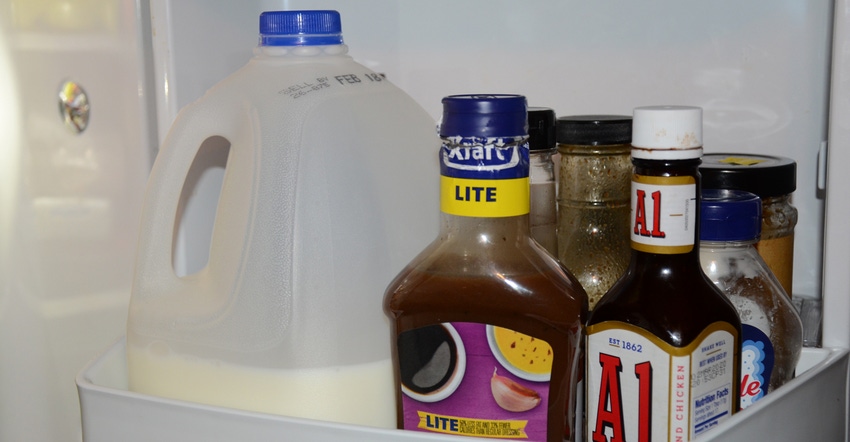
I’m that shopper who will eye every shelf of milk looking for the farthest out “sell by” date. I also never grab the loaf of bread facing me — I’ll dig behind to see if there is a fresher version.
Food waste is something I’m still struggling to get a handle on now that the steady stream of famished teenagers is no longer parading through the door. With just the two of us in the house now, the fresher the product, the longer it will last and the better chance of it getting consumed before it sours or develops a fungus.
I use those dates as a guide, but I’m not like cousin Kevin. He was known to chug a half gallon of milk the night before the sell by date. If he couldn’t get it all down, it got thrown out.
USDA estimates that 30% of the food supply is lost or wasted at the retail and consumer levels.
Milk is one of the most wasted food products in the U.S., representing 12% of consumer food waste by weight, according to Ohio State University researchers who say past research suggests the date label is a critical reason why milk goes down the drain.
Manufacturers provide dating to help consumers and retailers decide when food is of best quality. Except for infant formula, USDA is quick to point out that dates are not an indicator of the product’s safety.
In fact, most foods are safe to eat even after that sell by date has passed. They may not taste as good, because they’ve lost some freshness, but that doesn’t mean it’s going to send you to the hospital.
Companies want to supply fresh, tasty products, and the date helps protect the reputation of those products.
But for the Kevins out there, those dates are definitive and, out of fear of sickness, food gets tossed.
In reality, according to Eat By Date, once opened all milk lasts 4-7 days past its printed date, if refrigerated. If unopened, whole milk lasts 5-7 days, reduced-fat and skim milk last 7 days, and non-fat and lactose-free milk last 7-10 days past its printed date, if refrigerated.
And of course, where and how you store your milk is pivotal to its freshness. According to FDA, if milk is left unrefrigerated for more than two hours, it’s considered unsafe to consume.
And, even though fridge manufactures have built doors to accommodate whole gallons of milk, that’s not where you’re supposed to store it. Milk should at 38° to 40°F in the same container it came in, and not in the door because it’s being exposed to warm air each time it’s opened, which encourages bacterial growth.
Brian Roe, an OSU College of Food, Agricultural, and Environmental Sciences professor of agricultural economics, co-authored a new study examining consumer behavior regarding date labeling on milk containers. The goal of the research is to help consumers reduce food waste through improved food labeling systems and consumer education.
The study, which will appear in the June 2018 edition of Food Quality and Preference Journal, surveyed 88 consumers who were asked to sniff half-gallon jugs of milk that were 15, 25, 30 and 40 days past the date they were bottled. Some milk samples were dated and some were not dated.
The study found that 64% of respondents said they would throw the milk out that had a date label, while only 45.8% of respondents said they would throw the same milk out if they didn’t know the date label of the milk.
Roe leads the Ohio State Food Waste Collaborative, a collection of researchers, practitioners and students working together to promote the reduction and redirection of food waste.
“Pasteurized milk is safe past the sell by date unless it has been cross-contaminated,” Roe says. “While it may not taste as good — it can go sour and have flavors that people don’t like and may make them feel nausea — but it isn’t going to make them sick.”
Confusion regarding food label dates leads to significant food waste nationwide, with the average American household spending more than $2,000 annually on wasted food, according to a study by the Natural Resources Defense Council.
So what do the date labels on food mean?
According to the U.S. Department of Agriculture:
• The “best if used by/before” date indicates when a product will be of best flavor or quality. It is not a purchase or a safety date.
• The “sell by” date tells the store how long to display the product for sale for inventory management. It is not a safety date.
• The “use by” date is the last date recommended for the use of the product while at peak quality. It is not a safety date, except when used on infant formula.
Dennis Heldman, a CFAES professor of food engineering, member of the Food Waste Collaborative and co-author of the study, is researching the consumer effect of an indicator that would be attached to containers of perishable foods to monitor shelf life. The indicator would gradually change color during the storage and distribution of a food or beverage. A change in color, say, from blue to red, would tell consumers that the product has reached the end of its shelf life.
Heldman hopes this will allow consumers to be confident as to when a product should and shouldn’t be consumed.
I’ve pretty much relied on my schnoz. Usually a good whiff will deploy a gag reflex or have me going for a glass of milk. But then again, a little color-coding could be fun. And, if it helps consumers make better decisions, he might really be onto something.
About the Author(s)
You May Also Like






